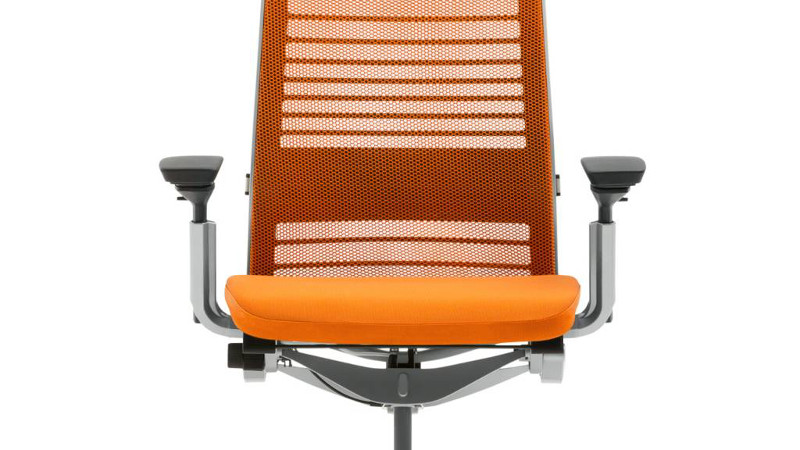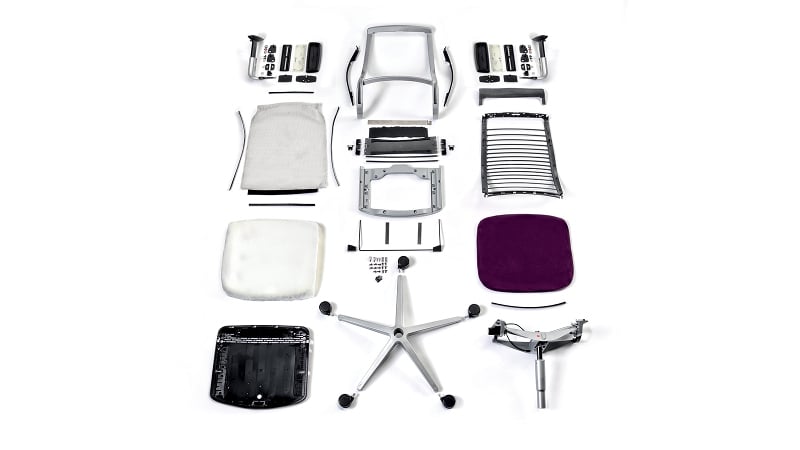Buy cheap and buy twice, the saying goes. But where budgets are squeezed and priorities are constantly changing the temptation can be to cut your office furniture expenses as much as possible. Right now, though, choosing a sustainable path in furniture procurement has never had more tangible and quantifiable business benefits.
The 'sustainable furniture' option has historically been more expensive for businesses, but we’re turning a corner now where the ‘right thing to do’ is also increasingly the best commercial option.

Circular economy designs out waste - and delivers savings
The circular economy is being embraced by business and incentivised by government. There’s a recognition that linear models of buy, consume and dispose are more expensive for everyone in the long term. Instead, a circular economy where we build for durability and second life - to repair, reuse and regenerate - can make sustainability a win-win situation for everyone (including maufacturers). In this world, what could be waste is always transformed into a resource.
Avoid landfill - and associated costs
Furniture built for the ‘linear economy’ is more likely to end up in landfill - since by definition it has a strictly limited life-cycle. In doing so, it has no chance of being resold, no chance of a useful second life and will end up costing you again for disposal. Depending on the quantity, condition, quality and composition of the furniture you consign to landfill those costs may increase exponentially. The costs of corporate waste disposal are rising every year and governments are more likely to fine and sanction companies sending more redundant and polluting equipment to the dump.
Choose furniture that can be repaired, recycled and repurposed
The ‘fast furniture’ production methods of the linear economy favour obsolescence to fuel a constant stream of sales. Through fusing joints and other cheap production methods - they come with few (if any) replaceable components - and the cost of repair or repholstery can often be higher than the cost of buying the item in the first place.
You can elongate your furniture’s lifespan by buying equipment made with replaceable parts designed for future re-covering and repair. And where possible, you should aim to acquire furniture built from recyclable materials for easier and cheaper disposal when their useful life is over.
In these days of post-Covid uncertainty, the future of our offices is one of change and transformation. Businesses are changing the way they use offices, turning their backs on ‘cubicle farms’ and replacing them with creative hubs that can be reconfigured on the fly according to the needs of business. These spaces need to be capable of switching between individual working scenarios and larger collaborative working methods. To meet these demands for agile and responsive spaces, you should consider buying more furniture that is as flexible as possible.
Choosing furniture that can be extended, adjusted or reconfigured to support different kinds of use will ensure they’re able to adapt with you as your business needs change and offices evolve in the years to come.
Buy for adaptability and you'll minimise the amount of replacements you'll need to make in the future and maximise your chance of resale or repurposing.
Reduce your carbon footprint - to reduce long term costs
The message of the circular economy is the more we aim to lower our carbon footprint the more opportunity there can be for overall, creative cost reduction, through:
- Using local supply chains
- Using more sustainable and recyclable raw materials
- Consuming less energy in production
- Creatively reusing wasted materials
- Minimising excessive and unrecyclable packaging
Think about Steelcase’s project to construct new furniture with 'planked-veneer', (oak and walnut pieces leftover from other processes) that cannot be used in other products.
Or what about the acoustic screens and materials being made out of plastic waste retrieved from the oceans?
In both cases waste is being reinvented as resource.
The LEVA chair is a fantastic example of a piece of furniture with a transparent life-cycle - where the manufacturing process itself is being optimised to diminish its over all environmental impact and its own cost of production:
Made of ash sustainably sourced from Eastern Europe, the LEVA chair is designed to reduce the amount of waste generated during its manufacture. Any timber discarded during the machining process is used to fuel the heating system at the factory, supplementing the photovoltaic panels on the factory roof.
The results are impressive, with a dramatically reduced carbon footprint that is the product of its own leaner production methods:
The EPD for the LEVA chair is 2.73 kg CO2eq for the un-upholstered chair, and 15.6-17.8 kgCO2eq for leather upholstered chairs. When the average carbon footprint of similar chairs is 43.9 kgCO2e.
Better design - better health
And better for the planet is also turning out to be better for our health, too.
Office furniture that is quick to dilapidate can fast become uncomfortable and unsafe to use. Not only this, but the cheaper foams and other fabric treatments that are typically used in cheaper furnishing have shown to cause many adverse health impacts.
Money saved by buying cheaper furniture can quickly be swallowed up by the cost of uncomfortable and unhappy workers working in unproductive postures. Longer term, the health implications could be even more extreme.
Fire retardants pose a serious risk to our health and are actually banned in other European countries. Some of these chemicals have been linked to cancer, delayed development and thyroid disruption.
Save the planet - win loyalty
Sustainability as a goal has until recently be seen as a ‘nice to have’ - but now that the full extent of the ransacking of natural resources within obscure supply chains is a centre of media attention - the medium and long term impact of even the simplest procurement decisions are well understood. Young people particularly are galvanised by these issues and the pressure is on for companies to respond with sustainability policies that match their expectations. As the authors of the report into Gen-Z workers discovered:
‘They expect consistency and authenticity and will call you out, often publicly, if they don’t see it. They will leave companies they believe are hiding or putting too much spin on bad news, ignoring their negative environmental or social impacts’
In the future, it will be more expensive to produce and pollute than it will be to build sustainably and responsibly. The tide is turning ethically and commercially - our customers and workers are demanding change - the market is responding to the need.
Sustainable choices are worth it - because they will safeguard our future and make new and creative economies more possible.











